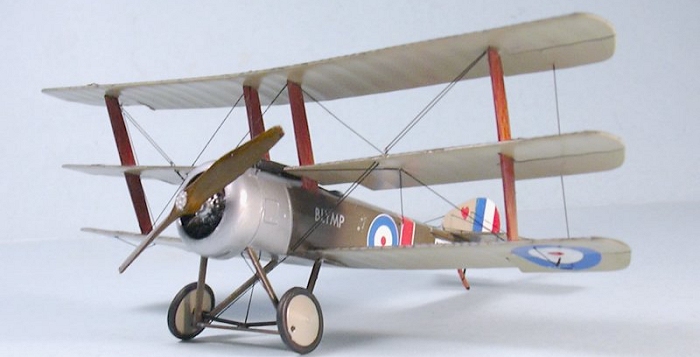
Eduard 1/48 Sopwith Triplane
| KIT #: | ? |
| PRICE: | $29.98 |
| DECALS: | Four options |
| REVIEWER: | Tom Cleaver |
| NOTES: | Profipack version |

| HISTORY |
The Sopwith Triplane - known to its Royal Naval Air Service pilots as the “Tripehound” - was developed from the biplane Pup in late 1916. The purpose of the triplane configuration was to maximize pilot view with narrow-chord wings and maximize maneuverability by increasing wing area without increasing wingspan. The result was a supremely maneuverable single-seat scout that had such a profound effect on its opponents that they paid it the ultimate compliment of copying it - directing all German aircraft manufacturers to submit designs for triplane fighters within weeks of the appearance of the Tripehound over the Western Front in the Spring of 1917. The Triplane was generally about 15 m.p.h. faster than the Albatros D.III and could easily outclimb its opponent; if the German chose to attack, the Triplane could out-turn the Albatros quickly, then outclimb it, thus allowing the RNAS pilot to choose his moment of attack.
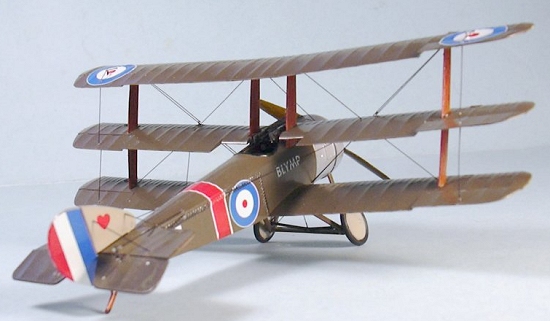 Flown by such
famous RNAS pilots as the Canadian Raymond Collishaw, American O.C.
“Boots” LeBoutillier, and Englishman Reggie Soar, the Sopwith Triplane went
far to re-establish British air superiority in the northern region of the
Western Front following the disaster of “Bloody April.” Powered by the 110
h.p. Clerget engine, the fighter suffered from a standard armament of only
one Vickers machine gun, though both Collishaw and Bob Little flew a
limited-production series of Triplanes armed with two machine guns despite
the deleterious effect on performance from the extra weight of the
additional weapon.
Flown by such
famous RNAS pilots as the Canadian Raymond Collishaw, American O.C.
“Boots” LeBoutillier, and Englishman Reggie Soar, the Sopwith Triplane went
far to re-establish British air superiority in the northern region of the
Western Front following the disaster of “Bloody April.” Powered by the 110
h.p. Clerget engine, the fighter suffered from a standard armament of only
one Vickers machine gun, though both Collishaw and Bob Little flew a
limited-production series of Triplanes armed with two machine guns despite
the deleterious effect on performance from the extra weight of the
additional weapon.
Such was the pace of technical development that the Triplane, which first appeared at the Front in February and only achieved widespread service in all four RNAS fighter squadrons - Naval 1, naval 8, Naval 9 and Naval 10 - by May, was considered obsolescent by late July and left front-line service by the end of August, 1917. Replaced by the tricky Sopwith Camel, the Tripehound was remembered by its pilots as a wonderful flying machine. It was far superior to the better-known Fokker Triplane, which suffered from only having ailerons on the upper wing, unlike the Tripehound which had ailerons on each wing and could fly rings around Fokker’s product.
Robert Alexander Little - The Australian Ace of Aces:
I am frequently struck when I read about various aces - particularly those from the First World War - by how much they are the personification of certain national stereotypes. Raymond Collishaw could never have been other than a Canadian, von Richtofen a Prussian, Guynemer or Fonck French, Rickenbacker an American. Reading about R.A. “Bob” Little, he comes across to me as the quintessential Australian.
Born in Melbourne, Victoria, on July 19, 1895, to parents who had emigrated from Scotland to Canada before coming on to Australia, Little was 19 and a year out of school when the First World War broke out. When he discovered there were already 500 applicants at Point Cook Military Flying School, he sailed for England at his own expense, where he spent 100 Pounds to learn to fly at Hendon, receiving his pilot certificate on October 27, 1915. He immediately enlisted in the Royal Naval Air Service and was commissioned a probationary Flight Sub-Lieutenant at Eastchurch in January 1916.
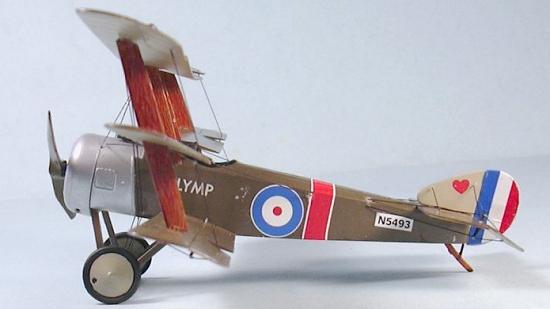 He was sent to
the Naval Air Station at Dunkirk that June, where he flew Sopwith Strutters
on reconnaissance along the Belgian and in attacks on German positions in
occupied Belgium.
He was sent to
the Naval Air Station at Dunkirk that June, where he flew Sopwith Strutters
on reconnaissance along the Belgian and in attacks on German positions in
occupied Belgium.
As the new German Jastas with their Albatros fighters appeared on the Western Front in the fall of 1916 and the British lost air superiority over the lines, the RNAS was drawn into the land battle to support the RFC, forming fighter squadrons at Dunkirk to fight under RFC command. “Naval Eight” - No. 8 (Naval) Squadron - was formed on October 25, 1916, with Little among its first pilots, assigned to "B" Flight under the command of another Australian, Stan Goble. Commanded by Squadron Commander G R Bromet, Naval Eight operated three flights of Nieuport 17s, Sopwith 1 1/2 Strutters and Sopwith Pups. That December, Naval Eight became the first all-Pup squadron in action.
Little scored his first victory, an Aviatik C.1, while flying Pup N5182, with a second two-seater just north of La Bassee on November 23. By mid-December he claimed two Halberstadt D.IIs, to become one of the leading scorers in the unit. On February 1, 1917 Naval Eight transferred their Pups to No. 3 (Naval) Squadron, while Naval Eight re-equipped at Dunkirk with the new Sopwith Triplane. They re-entered operations in late March on the Third Army Front near Arras. Their main opponents were von Richthofen's Albatros D.III-equipped Jasta II.
RFC squadrons were being run through the meatgrinder in the Spring of 1917, with the worst being “Bloody April,” the month Naval Eight entered combat. The Germans soon learned that the strange-looking Triplanes could easily out-fly the Albatros. Naval Eight made their first combat flights on April 5, just before the outbreak of the Battle of Arras. Little scored his first Triplane victory when he shot down a Jasta II Albatros over Lens on April 7, 1917. The British anti-aircraft unit that reported the fight stated “...a Sopwith Triplane, working alone, attacked 11 hostile machines... he completely outclassed the whole patrol of hostile machines, diving through them and climbing above them. One Albatros, painted red, dived on to him after he had shot down another and passed him. The Sopwith dived on him and forced the red machine to dive away, after which he climbed again above the whole patrol and attacked again. The officers who witnessed the combat report that the maneuvering of the Triplane completely outclassed the Albatros scouts.” Little had undoubtedly met Manfred von Richtofen for the first time.
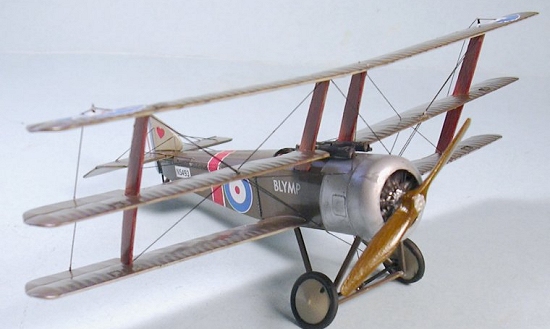 On April 24, he
attacked a DFW C.V, putting a bullet through its oil tank, then followed
its as it landed on a field behind Allied lines. The DFW made a perfect
landing, but when he attempted to land and take them prisoner, Little's
Triplane turned over on landing. As the German pilot, Leutnant Friedrich
Neumuller - who had been a Rhodes scholar at Oxford before the war - helped
Little out of the overturned Triplane, he remarked, “It rather looks as if
I have brought you down, not you me, doesn’t it?”
On April 24, he
attacked a DFW C.V, putting a bullet through its oil tank, then followed
its as it landed on a field behind Allied lines. The DFW made a perfect
landing, but when he attempted to land and take them prisoner, Little's
Triplane turned over on landing. As the German pilot, Leutnant Friedrich
Neumuller - who had been a Rhodes scholar at Oxford before the war - helped
Little out of the overturned Triplane, he remarked, “It rather looks as if
I have brought you down, not you me, doesn’t it?”
By May, Little had hit his stride. He had modified Triplane N5493 - one of a limited production run of Sopwiths distinguished by different tail surfaces and a twin-Vickers armament- by moving the seat forward 10 inches. This made the airplane nose-heavy and increased its diving speed, which was crucial for Little who initiated his battles with a fast dive into the middle of an enemy formation. Named “Blymp” for his son who had been born the year before, N5493 was unflyable to other pilots due to its seating configuration which put it out of rig. By May 26, his tally stood at 20. He was relentless in battle, closing to within 15-20 feet of an opponent before opening fire. A crack shot, he would only break off a fight when he had exhausted his ammunition.
On June 26, Little attacked another Aviatik C.V, flown by pilot Gefreiter Ernst Bittorf and observer Leutnant Karl Schweizer of Flieger Abteilung 269. Little wrote in his report, “I stalled up and fired a burst of 20 rounds at a range of 50 yards. The Hun Aircraft stalled and dived west... it dived past the vertical and came back east on its back. Something then fell out - I think it was a man... I caught up with it and saw a man crawling along the fuselage, trying to get to the bottom (the machine was still on its back and was now on fire). I closed and fired about 20rounds and the man fell off. The machine carried on down to about 180 feet where it broke up and crashed.”
Fellow Naval Eight ace Reggie Soar wrote of Little: “On the Somme front he was immediately successful in fights in the air, as he was with tricks on the ground. For example, the pilots would often take a tender into Amiens for dinner at the Godbert. Very often we would get stuck behind a car full of French officers en route, who would not give way... Little would pull out his revolver and shoot a nice round hole in the rear tyre of their tourer. He never missed! He was an outstanding shot with both revolver and rifle, and a collector of wild flowers. He had few equals in air fighting, and though not a polished pilot, he was one of the most aggressive.”
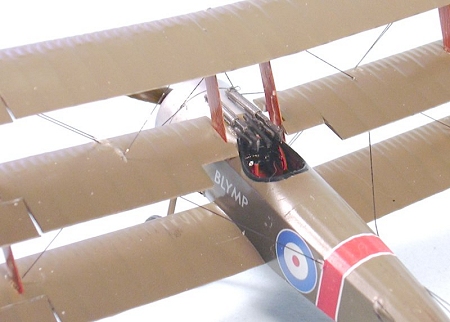 R.J.O. Compston,
Little’s commanding officer, wrote of him, “Once Little came within range
of an enemy he did not give up until, first, the enemy was shot down,
secondly his own engine failed, or thirdly, he ran out of ammunition. He
had in human guise the fighting qualities of a bulldog. He never let go.”
R.J.O. Compston,
Little’s commanding officer, wrote of him, “Once Little came within range
of an enemy he did not give up until, first, the enemy was shot down,
secondly his own engine failed, or thirdly, he ran out of ammunition. He
had in human guise the fighting qualities of a bulldog. He never let go.”
Little scored his last Triplane victory on July 10, for a total of 20 since April 7. “Blymp” was the second most-successful Triplane after Collishaw’s “Black Prince,” N5492.
Little was pulled out of combat in August, but got himself posted to “Naval Three” - later 203 Squadron RAF, commanded by Raymond Collishaw. On April 21, 1918, the day von Richthofen was killed, Little picked off “tail-end Charlie” of a formation of twelve from Jasta Boelcke. Six Fokkers turned on Little's Camel and shot away his controls. The Camel dove to less than 100 feet of the ground before flattening out with a jerk. Little, who had having unstrapped his seat belt, was thrown clear as the Camel ploughed into the ground north of the Forest of Nieppe. When two enemy aircraft dove to strafe the wreck, Little blazed away with his pistol until he was joined by British infantry with Lewis guns.
On the morning of May 28, 1918, Major Booker - Little's comrade from Naval Eight and now Officer Commanding 201 Squadron, was summoned to where a Camel had crashed in the French lines. The pilot - still at the controls with a bullet through his heart - was Little. He had taken off the previous evening to intercept German Gothas, and was apparently killed by one of the gunners.
Bob Little had a score of 47 at the time of his death - 4 in Pups, 27 in his Triplane, and 16 in Camels - making him the Australian Ace of Aces. He was buried in Wavans cemetery.
| THE KIT |
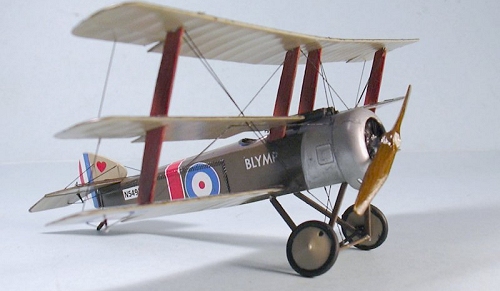 Eduard’s Sopwith
Triplane first appeared in late 1995, and was the first Eduard kit to not
be a limited-run product. Originally released with the early “Pup”
horizontal stabilizer, a limited kit was released in 1996 with decals for
the famous “Black Flight” of Naval Ten, with a resin horizontal stabilizer
of the later shape.
Eduard’s Sopwith
Triplane first appeared in late 1995, and was the first Eduard kit to not
be a limited-run product. Originally released with the early “Pup”
horizontal stabilizer, a limited kit was released in 1996 with decals for
the famous “Black Flight” of Naval Ten, with a resin horizontal stabilizer
of the later shape.
This re-release as a “Profipack” kit includes both the plastic and resin horizontal stabilizers, the single gun and twin gun mounts with machine guns in resin, photo-etch detail parts, an injected plastic engine and a more detailed resin engine. Decals are provided for four aircraft, including the Triplane flown by Bob Little, though the name “Blymp” is not included for some strange reason.
| CONSTRUCTION |
 Construction begins with the cockpit, which has all the detail one needs in
injection plastic and photo-etch. I used the photo-etch wicker seat,
positioning it a scale 10 inches forward of the standard position, to
replicate Little’s modification of his airplane. Once this was assembled I
closed up the fuselage and turned to the engine. Eduard provides a Clerget
engine in resin and injection-molded plastic. I used the excellent resin
version.
Construction begins with the cockpit, which has all the detail one needs in
injection plastic and photo-etch. I used the photo-etch wicker seat,
positioning it a scale 10 inches forward of the standard position, to
replicate Little’s modification of his airplane. Once this was assembled I
closed up the fuselage and turned to the engine. Eduard provides a Clerget
engine in resin and injection-molded plastic. I used the excellent resin
version.
The wings were modified by cutting the ailerons loose and posing them, which I also did with the resin horizontal stabilizer and the rudder. Once I had the lower wings attached to the fuselage, it was time for painting.
| COLORS & MARKINGS |
I painted the cowling and forward fuselage with Alclad II “Polished Aluminum.” I then masked off that area, pre-shaded the rest of the model, and then painted it Clear Doped Linen on the lower surfaces with Gunze-Sangyo “Sail Color” and P.C.10 for the upper surfaces, using Tamiya “Khaki.” When that was dry, I gave the parts a coat of Future.
Decals:
The kit decals went on easily. I asked my friend John Lester to print a “Blymp” decal for me on his ALPS, which gave me all the markings for Little’s Triplane. When these were dry, I gave the model a coat of Xtracrylix “Satin” varnish. I also stained the lower fuselage with Tamiya “Smoke” to simulate the exhaust staining from a rotary engine.
| FINAL CONSTRUCTION |
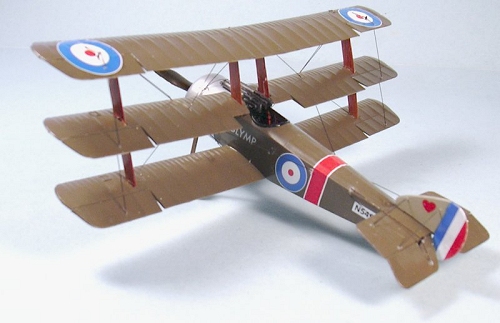 I unmasked the
cowling, attached the twin Vickers machine guns, then attached the tail
surfaces. After gluing the landing gear on - being certain to “cant” the
wheels the way they are on the ground with any Sopwith airplane, I attached
the cabane struts. I slide the interplane struts into position in the
middle wing, then attached the middle wings. The top wing went on last and
the model was ready for rigging. The Sopwith Triplane has a simple rigging,
which I did with .006 brass wire painted black.
I unmasked the
cowling, attached the twin Vickers machine guns, then attached the tail
surfaces. After gluing the landing gear on - being certain to “cant” the
wheels the way they are on the ground with any Sopwith airplane, I attached
the cabane struts. I slide the interplane struts into position in the
middle wing, then attached the middle wings. The top wing went on last and
the model was ready for rigging. The Sopwith Triplane has a simple rigging,
which I did with .006 brass wire painted black.
| CONCLUSIONS |
The Sopwith Triplane is one of my favorite World War I airplanes, and one of Eduard’s best kits ever, that results in a very distinctive-looking model. As World War I kits go, it is not that difficult a project, and would be a good “step up” for a modeler with a kit like Eduard’s Nieuport 17 under their belt. This Profipack version gives you all the added detail and options you could ask for.
March 2005
Copyright ModelingMadness.com
Thanks to Eduard for the review kit.
If you would like your product reviewed fairly and fairly quickly, please contact the editor or see other details in the Note to Contributors.